Saturday Morning Fever: CBS 1974
I have always said that I appreciate the full experience of reading a comic book from cover to cover. That includes the advertisements, letter page, and any other ancillary entertainment found within the pages. That’s also why I would rather have a poor condition copy of an original comic book than a brand new treasury edition reprinting. On a recent mission to convert my comic collection storage over to a new type of drawer box, I couldn’t resist revisiting a few classic issues and found some great newsprint nostalgia. The two page add featured this week ran in DC comics in the fall of 1974 to promote the CBS Saturday morning lineup. These days there is hardly any network programming for children on Saturday mornings but up until the late 1980’s it was a major event.
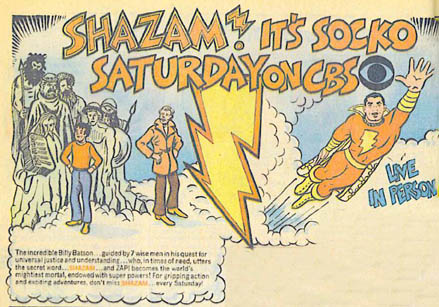 The most significant event in this entire advertisement is clearly the premier of the Shazam series. The Fawcett comic’s character had already been around for over thirty years (and starred in his own Republic serial) by the time he debuted as a kid’s show. The simple concept of a young boy being gifted with the powers of the Greek gods and the ability to transform into an adult superhero seems like the perfect set up for a Saturday morning series but Filmation dropped the ball big time. What we got here was a punk looking Billy Batson and some new character called Mentor (clever, huh?) traveling around the country in an RV. Each week they would run into some new idiot teen that karma had singled out for a butt kicking after they shoplifted or drank alcohol or something. Billy was so inept, he had to consult with bad cartoon drawings of his patron gods each week so they could give him crappy advice and he could pass it on to the audience. Kids like me caught up on their sleep for about 20 minutes or channel surfed until we heard the magic word “shazam” and Captain Marvel finally showed up. Sadly Marvel never really got a chance to do many super antics due to the show’s low budget. Somehow this show managed to last a couple of seasons and even inspired a spin off show for girls in need of a morality check, Isis.
The most significant event in this entire advertisement is clearly the premier of the Shazam series. The Fawcett comic’s character had already been around for over thirty years (and starred in his own Republic serial) by the time he debuted as a kid’s show. The simple concept of a young boy being gifted with the powers of the Greek gods and the ability to transform into an adult superhero seems like the perfect set up for a Saturday morning series but Filmation dropped the ball big time. What we got here was a punk looking Billy Batson and some new character called Mentor (clever, huh?) traveling around the country in an RV. Each week they would run into some new idiot teen that karma had singled out for a butt kicking after they shoplifted or drank alcohol or something. Billy was so inept, he had to consult with bad cartoon drawings of his patron gods each week so they could give him crappy advice and he could pass it on to the audience. Kids like me caught up on their sleep for about 20 minutes or channel surfed until we heard the magic word “shazam” and Captain Marvel finally showed up. Sadly Marvel never really got a chance to do many super antics due to the show’s low budget. Somehow this show managed to last a couple of seasons and even inspired a spin off show for girls in need of a morality check, Isis.
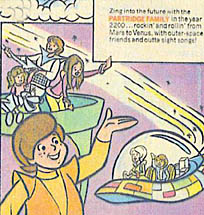 Have you ever looked at something for the first time and just thought – what the hell? That’s exactly how I felt the first time I saw the advertisement for The Partridge Family 2200 AD! I was never a big fan of the regular Partridge Family show and I certainly couldn’t wrap my mind around how they managed to end up over 200 years into the future. A few years earlier, Hanna Barbara sent Josie & the Pussycats into outer space (and thankfully they never came back) so I guess they thought this might breath life into the Partridges too. At least they did manage to get the original voices of Susan Dey, Danny Bonaduce, and a few other minor members of the live show’s cast involved. Shirley Jones, David Cassidy, and even Dave Madden were smart enough to stay away! The future Partridges only lasted one year but the show managed to produce a lot of tie in merchandise including a pretty rare soundtrack album.
Have you ever looked at something for the first time and just thought – what the hell? That’s exactly how I felt the first time I saw the advertisement for The Partridge Family 2200 AD! I was never a big fan of the regular Partridge Family show and I certainly couldn’t wrap my mind around how they managed to end up over 200 years into the future. A few years earlier, Hanna Barbara sent Josie & the Pussycats into outer space (and thankfully they never came back) so I guess they thought this might breath life into the Partridges too. At least they did manage to get the original voices of Susan Dey, Danny Bonaduce, and a few other minor members of the live show’s cast involved. Shirley Jones, David Cassidy, and even Dave Madden were smart enough to stay away! The future Partridges only lasted one year but the show managed to produce a lot of tie in merchandise including a pretty rare soundtrack album.
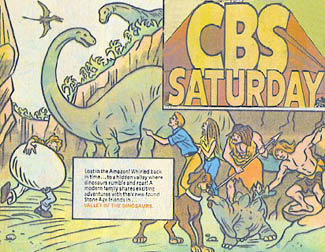 1974 must have been the year of the nuclear family versus the dinosaurs! While the live-action Land of the Lost was busy premiering on the NBC network this season, CBS tried a similar animated version with Valley of the Dinosaurs. A family lost in the depths of the Amazon jungle discovers a tribe of cave people and prehistoric animals that still survive in modern times (they could have called this Cave Clan: 1974 AD and teamed this show up with the Partridges!). Each week’s episode would feature the family finding some way to hopefully escape from the valley and/or having to deal with some new threat or danger without being able to call 911.Land of the Lost developed a cult following and lasted for three seasons while Valley of the Dinosaurs ended up lost for good after just one year.
1974 must have been the year of the nuclear family versus the dinosaurs! While the live-action Land of the Lost was busy premiering on the NBC network this season, CBS tried a similar animated version with Valley of the Dinosaurs. A family lost in the depths of the Amazon jungle discovers a tribe of cave people and prehistoric animals that still survive in modern times (they could have called this Cave Clan: 1974 AD and teamed this show up with the Partridges!). Each week’s episode would feature the family finding some way to hopefully escape from the valley and/or having to deal with some new threat or danger without being able to call 911.Land of the Lost developed a cult following and lasted for three seasons while Valley of the Dinosaurs ended up lost for good after just one year.
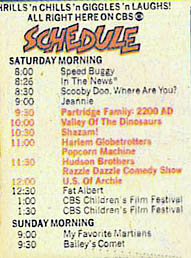 I’m not sure what is harder to believe, that so much ’70’s Saturday morning programming was comprised of live action shows or that so many of these shows were such crap. There were a lot of good live-action shows, mainly from Krofft and Filmation, but there were also some truly bizarre entries like The Harlem Globetrotter’s Popcorn Machine and The Hudson Brothers Razzle Dazzle Comedy Show. Both programs followed similar formats — short sketches and vignettes loosely based around a central theme like pollution or eating healthy. The Globetrotter’s were right in the middle of their impressive Saturday morning run, having just come from their own self-titled cartoon show and heading towards the Super Globetrotters a few years down the road. They were coupled with the prototype for Gary Coleman and Emmanuel Lewis, Rodney Allen Rippy (a kid whose career pretty much started and ended with a series of Jack in the Box commercials) and a weekly celebrity guest. The Hudson Brothers were a fairly popular comedy team in their native Canada and their show featured a stronger supporting cast including Murray Langston (The Unknown Comic), Gary Owens and Rod Hull and his emu! Both shows were short on entertainment and long on pro social values which put them on a quick ride to cancellation city!
I’m not sure what is harder to believe, that so much ’70’s Saturday morning programming was comprised of live action shows or that so many of these shows were such crap. There were a lot of good live-action shows, mainly from Krofft and Filmation, but there were also some truly bizarre entries like The Harlem Globetrotter’s Popcorn Machine and The Hudson Brothers Razzle Dazzle Comedy Show. Both programs followed similar formats — short sketches and vignettes loosely based around a central theme like pollution or eating healthy. The Globetrotter’s were right in the middle of their impressive Saturday morning run, having just come from their own self-titled cartoon show and heading towards the Super Globetrotters a few years down the road. They were coupled with the prototype for Gary Coleman and Emmanuel Lewis, Rodney Allen Rippy (a kid whose career pretty much started and ended with a series of Jack in the Box commercials) and a weekly celebrity guest. The Hudson Brothers were a fairly popular comedy team in their native Canada and their show featured a stronger supporting cast including Murray Langston (The Unknown Comic), Gary Owens and Rod Hull and his emu! Both shows were short on entertainment and long on pro social values which put them on a quick ride to cancellation city!
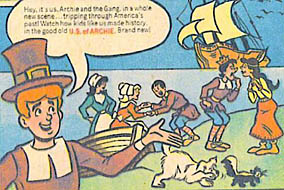 The final new entry for 1974 could easily give the Partridge Family of the future a run for their money. The popular characters of Archie Comics were sent back in time to various events of historical significance in the U.S. of Archie show (OK, if we call this Archie: Circa 1776 AD, we’ve got a triple bill!). The gang from Riverdale High had enjoyed several years of success in various Saturday morning shows and the nation was already caught up in a wave of patriotism for a bicentennial anniversary that was still over a year away. Combining the two themes probably seemed like a sure fire hit to CBS executives but savvy kids saw right through the thinly disguised educational content and switched the channel in droves. The show was canceled after its initial sixteen episode run but managed to survive in repeats until the fall of 1976.
The final new entry for 1974 could easily give the Partridge Family of the future a run for their money. The popular characters of Archie Comics were sent back in time to various events of historical significance in the U.S. of Archie show (OK, if we call this Archie: Circa 1776 AD, we’ve got a triple bill!). The gang from Riverdale High had enjoyed several years of success in various Saturday morning shows and the nation was already caught up in a wave of patriotism for a bicentennial anniversary that was still over a year away. Combining the two themes probably seemed like a sure fire hit to CBS executives but savvy kids saw right through the thinly disguised educational content and switched the channel in droves. The show was canceled after its initial sixteen episode run but managed to survive in repeats until the fall of 1976.
Speaking of repeats, the remainder of CBS’s 1974 fall lineup is padded out with them. Speed Buggy, the animated reworking of I Dream of Jeanie, Fat Albert and his gang of ghetto moralizing friends, and the sameScooby Doo cartoons that had been circulating since 1969! The only one of these new shows that enjoyed any success was Shazam, which returned the next season in an expanded one hour version paired with Isis. Live-action programs were popular (and cheap) for many years but gradually gave way to an almost exclusively animated lineup on all networks. Based on some of the “gems” from 1974 it’s not hard to see why!
